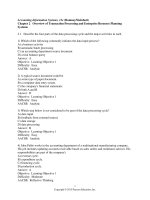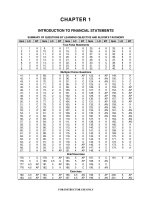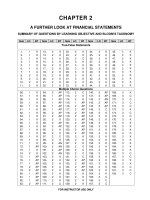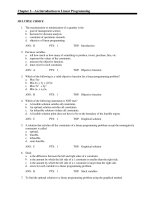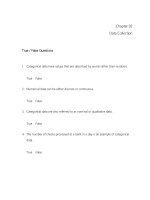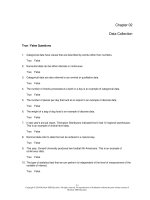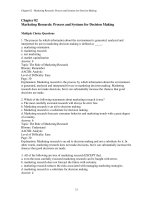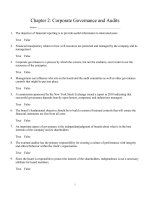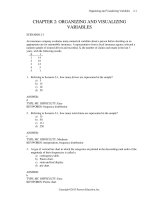Business communication today 13th edition bovee test bank
Bạn đang xem bản rút gọn của tài liệu. Xem và tải ngay bản đầy đủ của tài liệu tại đây (112.84 KB, 40 trang )
Business Communication Today, 13e (Bovee)
Chapter 2 Conflict, Interpersonal Communication, and Business Etiquette
1) As an approach to resolving conflict during team activities, a ________ proposes that both
sides can satisfy their goals (at least to some extent) and seeks to minimize losses for everyone
involved.
A) lose-win strategy
B) lose-lose strategy
C) win-win strategy
D) break-even strategy
Answer: C
Explanation: C) If you approach conflict with the idea that both sides can satisfy their goals to at
least some extent (a win-win strategy), you can minimize losses for everyone.
Diff: 2
Skill: Concept
Learning Obj.: LO 2.1: List the advantages and disadvantages of working in teams, describe the
characteristics of effective teams, and highlight four key issues of group dynamics
AACSB: Interpersonal relations and teamwork
Learning Outcome: Describe best practices in team and interpersonal communication
2) In participative management
A) employees are involved in the company's decision making.
B) all top-level managers participate in profit sharing.
C) teams are discouraged in favor of individual achievement.
D) an authoritarian management model is used.
Answer: A
Explanation: A) Participative management's aim is to improve decision making and efficiency
by including employees in the decision-making process.
Diff: 2
Skill: Concept
Learning Obj.: LO 2.1: List the advantages and disadvantages of working in teams, describe the
characteristics of effective teams, and highlight four key issues of group dynamics
AACSB: Written and oral communication
Learning Outcome: Describe best practices in team and interpersonal communication
1
Copyright © 2016 Pearson Education, Inc.
3) All of the following except ________ are elements of the group development process.
A) anticipation
B) emergence
C) brainstorming
D) reinforcement
Answer: A
Explanation: A) According to the textbook, teams evolve through the following five stages:
orientation, conflict, brainstorming, emergence, and reinforcement.
Diff: 2
Skill: Synthesis
Learning Obj.: LO 2.1: List the advantages and disadvantages of working in teams, describe the
characteristics of effective teams, and highlight four key issues of group dynamics
AACSB: Interpersonal relations and teamwork
Learning Outcome: Describe best practices in team and interpersonal communication
4) A ________ usually has a long life span and typically deals with regularly recurring tasks.
A) task force
B) work group
C) committee
D) problem-solving team
Answer: C
Explanation: C) Committees are formal teams that usually have a long life span and can become
a permanent part of the organizational structure.
Diff: 2
Skill: Application
Learning Obj.: LO 2.1: List the advantages and disadvantages of working in teams, describe the
characteristics of effective teams, and highlight four key issues of group dynamics
AACSB: Interpersonal relations and teamwork
Learning Outcome: Describe best practices in team and interpersonal communication
5) Which one of the following is NOT a dysfunctional team role?
A) Controlling
B) Diverting
C) Initiating
D) Withdrawing
Answer: C
Explanation: C) Controlling, withdrawing, attention seeking, and diverting are dysfunctional,
self-oriented roles that mainly fulfill individual rather than team needs.
Diff: 2
Skill: Application
Learning Obj.: LO 2.1: List the advantages and disadvantages of working in teams, describe the
characteristics of effective teams, and highlight four key issues of group dynamics
AACSB: Interpersonal relations and teamwork
Learning Outcome: Describe best practices in team and interpersonal communication
2
Copyright © 2016 Pearson Education, Inc.
6) Which of the following is NOT a way that teams help organizations to succeed?
A) Increase information and knowledge
B) Increase groupthink among members
C) Increase performance levels
D) Increase diversity of views
Answer: B
Explanation: B) Groupthink is the harmful tendency within groups that pressures members to
conform to the majority or a few influential leaders. Increasing groupthink would decrease the
likelihood of success for a team.
Diff: 1
Skill: Critical Thinking
Learning Obj.: LO 2.1: List the advantages and disadvantages of working in teams, describe the
characteristics of effective teams, and highlight four key issues of group dynamics
AACSB: Interpersonal relations and teamwork
Learning Outcome: Describe best practices in team and interpersonal communication
7) Groupthink refers to
A) the willingness of individual group members to withhold contrary or unpopular opinions,
even when those objections are legitimate, and to favor majority opinion.
B) the four-step decision-making process in groups.
C) software programs that help groups make decisions.
D) the basic rules that underlie a group's behavior and guide the group to make its decisions.
Answer: A
Explanation: A) When groupthink occurs, all group members tend to agree with the consensus.
Groupthink arises when group members see little to gain and a lot to risk in expressing opinions
that are not congruent with the prevailing views of the group.
Diff: 1
Skill: Concept
Learning Obj.: LO 2.1: List the advantages and disadvantages of working in teams, describe the
characteristics of effective teams, and highlight four key issues of group dynamics
AACSB: Interpersonal relations and teamwork
Learning Outcome: Describe best practices in team and interpersonal communication
3
Copyright © 2016 Pearson Education, Inc.
8) A hidden agenda refers to
A) a meeting agenda that is not revealed to others outside the meeting group.
B) individuals harboring motives, which they conceal from the rest of the group.
C) an agenda that members must look for before they can attend a meeting.
D) an approach to group dynamics that helps facilitate group functioning.
Answer: B
Explanation: B) A hidden agenda is an unexpressed plan that is harbored by one member of the
group but unknown to the rest of the group. An example of a hidden agenda would be a team
member who conceals his plans to depose the group leader and take over leadership of the group.
Diff: 2
Skill: Concept
Learning Obj.: LO 2.1: List the advantages and disadvantages of working in teams, describe the
characteristics of effective teams, and highlight four key issues of group dynamics
AACSB: Interpersonal relations and teamwork
Learning Outcome: Discuss the challenges and importance of business communication
9) You and several coworkers serve on a task force charged with updating the company's
personnel-policy manual. To proceed effectively, you should concentrate on
A) pointing out as many typos, misspellings, and grammatical errors as possible.
B) ensuring that all members have a clear and shared sense of purpose.
C) making other team members feel good.
D) doing all of the above.
Answer: B
Explanation: B) Successful groups have a common sense of purpose and an open and honest
way of making decisions. When people fail to understand the purpose of the group, the group can
have a hard time achieving its objectives.
Diff: 2
Skill: Synthesis
Learning Obj.: LO 2.1: List the advantages and disadvantages of working in teams, describe the
characteristics of effective teams, and highlight four key issues of group dynamics
AACSB: Interpersonal relations and teamwork
Learning Outcome: Describe best practices in team and interpersonal communication
10) Group members who are motivated mainly to fulfill personal needs play a
A) team-maintenance role.
B) task-facilitating role.
C) self-oriented role.
D) coordinating role.
Answer: C
Explanation: C) Self-oriented group members who aren't motivated by group goals tend to be
unproductive and can often drag a group into being dysfunctional.
Diff: 1
Skill: Concept
Learning Obj.: LO 2.1: List the advantages and disadvantages of working in teams, describe the
characteristics of effective teams, and highlight four key issues of group dynamics
AACSB: Interpersonal relations and teamwork
Learning Outcome: Describe best practices in team and interpersonal communication
4
Copyright © 2016 Pearson Education, Inc.
11) One member of a task force on which you serve is particularly good at helping other
members get along and work through their differences. This individual plays a
A) team-maintenance role.
B) task-oriented role.
C) self-oriented role.
D) coordinating role.
Answer: A
Explanation: A) Group members who fulfill a team maintenance role make sure that everyone in
the group is focused on group tasks. These members spend time and energy to avoid conflicts
and to make sure that group members don't feel resentful or bitter about group activities.
Diff: 2
Skill: Application
Learning Obj.: LO 2.1: List the advantages and disadvantages of working in teams, describe the
characteristics of effective teams, and highlight four key issues of group dynamics
AACSB: Interpersonal relations and teamwork
Learning Outcome: Describe best practices in team and interpersonal communication
12) During the ________ of the group-development process, the members of a problem-solving
team would begin to discuss their positions and become more assertive in establishing their roles.
A) conflict phase
B) reinforcement phase
C) orientation phase
D) brainstorming phase
Answer: A
Explanation: A) In the conflict phase of the group-development process, different opinions and
perspectives begin to emerge. During orientation, team members get to know one another. Roles
are established during orientation, and group members begin developing group norms and goals.
Diff: 1
Skill: Concept
Learning Obj.: LO 2.1: List the advantages and disadvantages of working in teams, describe the
characteristics of effective teams, and highlight four key issues of group dynamics
AACSB: Interpersonal relations and teamwork
Learning Outcome: Describe best practices in team and interpersonal communication
5
Copyright © 2016 Pearson Education, Inc.
13) Only one sales representative can go to the conference in Hawaii, but both Susan and Sean
want to go. After much discussion and arguing, they draw straws and Susan gets the trip. This is
an example of
A) a win-lose situation.
B) the five-step decision-making process.
C) the best way to deal with a conflict.
D) all of the above.
Answer: A
Explanation: A) A win-lose situation is a zero-sum way of resolving a conflict: one party
benefits from the outcome, but the other party is harmed. If possible, win-lose conflict resolution
should be avoided because it can breed resentment and other problems.
Diff: 2
Skill: Critical Thinking
Learning Obj.: LO 2.1: List the advantages and disadvantages of working in teams, describe the
characteristics of effective teams, and highlight four key issues of group dynamics
AACSB: Reflective thinking
Learning Outcome: Describe best practices in team and interpersonal communication
14) When you encounter someone who is resistant to change
A) confront the person aggressively.
B) overcome resistance with logic.
C) empathize with the person's concerns.
D) tell that person to quit whining and get back to work.
Answer: C
Explanation: C) When a person in a group resists change, express understanding and bring the
issue out into the open, where it can be dealt with directly. Encourage the person to express his
or her objections to the change. Then, resolve the issue firmly and fairly.
Diff: 3
Skill: Critical Thinking
Learning Obj.: LO 2.1: List the advantages and disadvantages of working in teams, describe the
characteristics of effective teams, and highlight four key issues of group dynamics
AACSB: Interpersonal relations and teamwork
Learning Outcome: Describe best practices in team and interpersonal communication
6
Copyright © 2016 Pearson Education, Inc.
15) ________ refers to working together to meet complex challenges.
A) Collation
B) Collaboration
C) Gathering
D) Meeting up
Answer: B
Explanation: B) Collaboration (working together to solve complex problems) is an essential skill
for knowledge workers in every profession.
Diff: 1
Skill: Concept
Learning Obj.: LO 2.1: List the advantages and disadvantages of working in teams, describe the
characteristics of effective teams, and highlight four key issues of group dynamics
AACSB: Interpersonal relations and teamwork
Learning Outcome: Describe best practices in team and interpersonal communication
16) Group loyalty can lead members into ________, a willingness to set aside personal opinions
and go along with everyone else, even if everyone else is wrong.
A) renegotiation
B) collaboration
C) groupthink
D) teamwork
Answer: C
Explanation: C) Groupthink occurs when group members for some reason (intimidation, risk
aversion, or over-dominant group leadership, for example) are unwilling to provide meaningful
input into the group. Groupthink usually results in the group making decisions that do not take
the views of all group members into account. Frequently, this failure to see all sides of the issue
yields poor decisions and poor outcomes.
Diff: 2
Skill: Concept
Learning Obj.: LO 2.1: List the advantages and disadvantages of working in teams, describe the
characteristics of effective teams, and highlight four key issues of group dynamics
AACSB: Interpersonal relations and teamwork
Learning Outcome: Describe best practices in team and interpersonal communication
7
Copyright © 2016 Pearson Education, Inc.
17) Sometimes, a group member may have a hidden agenda: a private, counterproductive motive
that will affect the group's interaction. All of the following except the desire to ________ are
examples of possible hidden agendas.
A) take control of the group
B) reconcile schedule conflicts for group meetings
C) undermine someone else on the team
D) pursue a business goal that runs counter to the group's mission
Answer: B
Explanation: B) Some team members may have a hidden agenda: a private, counterproductive
motive, such as a desire to take control of the group, to undermine someone else on the team, or
to pursue a business goal that runs counter to the team's mission.
Diff: 2
Skill: Concept
Learning Obj.: LO 2.1: List the advantages and disadvantages of working in teams, describe the
characteristics of effective teams, and highlight four key issues of group dynamics
AACSB: Interpersonal relations and teamwork
Learning Outcome: Describe best practices in team and interpersonal communication
18) The term ________ refers to the interactions and processes that take place among the
members of a team.
A) group dynamics
B) process reconciliations
C) interpersonal rotations
D) cross-functional interlocutions
Answer: A
Explanation: A) Group dynamics comprise the interactions and processes that take place among
the members of a team.
Diff: 2
Skill: Concept
Learning Obj.: LO 2.1: List the advantages and disadvantages of working in teams, describe the
characteristics of effective teams, and highlight four key issues of group dynamics
AACSB: Interpersonal relations and teamwork
Learning Outcome: Describe best practices in team and interpersonal communication
8
Copyright © 2016 Pearson Education, Inc.
19) ________ are informal standards of conduct that members share and that guide member
behavior.
A) Norms
B) Expectations
C) Dynamics
D) Responsibilities
Answer: A
Explanation: A) Productive teams tend to develop clear norms, which are informal standards of
conduct that members share and that guide the behavior of the team's members.
Diff: 2
Skill: Concept
Learning Obj.: LO 2.1: List the advantages and disadvantages of working in teams, describe the
characteristics of effective teams, and highlight four key issues of group dynamics
AACSB: Interpersonal relations and teamwork
Learning Outcome: Describe best practices in team and interpersonal communication
20) In the ________ phase of team evolution, team members reach a decision and find a solution
that is acceptable enough for all members to support (even if they have reservations).
A) orientation
B) reinforcement
C) emergence
D) brainstorming
Answer: C
Explanation: C) The emergence stage is the stage in which the group comes together and finds a
solution to the problem it is attempting to solve that all find acceptable. Note that the solution
may not be ideal in the minds of all group members, but it at least meets the minimum
requirements of their approval.
Diff: 2
Skill: Concept
Learning Obj.: LO 2.1: List the advantages and disadvantages of working in teams, describe the
characteristics of effective teams, and highlight four key issues of group dynamics
AACSB: Interpersonal relations and teamwork
Learning Outcome: Describe best practices in team and interpersonal communication
21) A team consists of two or more people who share a mission and the responsibility for
working to achieve their goals.
Answer: TRUE
Explanation: A team can consist of as few as two people. What makes the association a team is
that the people collaboratively work together to achieve some common goal.
Diff: 1
Skill: Concept
Learning Obj.: LO 2.1: List the advantages and disadvantages of working in teams, describe the
characteristics of effective teams, and highlight four key issues of group dynamics
AACSB: Interpersonal relations and teamwork
Learning Outcome: Describe best practices in team and interpersonal communication
9
Copyright © 2016 Pearson Education, Inc.
22) Cross-functional teams perform several roles, even though they contain employees from the
same department or division.
Answer: FALSE
Explanation: The reverse is true. A cross-functional team assembles employees from different
departments with different skills for the expressed purpose of solving a single problem or
addressing a single issue.
Diff: 2
Skill: Concept
Learning Obj.: LO 2.1: List the advantages and disadvantages of working in teams, describe the
characteristics of effective teams, and highlight four key issues of group dynamics
AACSB: Interpersonal relations and teamwork
Learning Outcome: Describe best practices in team and interpersonal communication
23) In an effective team, one leader takes charge and makes all decisions with little to no input
from other team members.
Answer: FALSE
Explanation: Teams that are dominated by a single individual tend to be less successful than
teams that reach decisions by a more democratic means. Overly dominant team members tend to
erode trust within the team, and trust between team members is usually the most important
element for overall team success.
Diff: 2
Skill: Concept
Learning Obj.: LO 2.1: List the advantages and disadvantages of working in teams, describe the
characteristics of effective teams, and highlight four key issues of group dynamics
AACSB: Interpersonal relations and teamwork
Learning Outcome: Describe best practices in team and interpersonal communication
24) In the phenomenon of groupthink, the team may arrive at poor-quality decisions and even act
unethically.
Answer: TRUE
Explanation: Groupthink can lead a team into making disastrous decisions. The essence of
groupthink usually lies in two dynamics: one person or a few people dominating the agenda, and
others in the group who are afraid to speak up or drowned out when they do speak up. The result
is a false consensus in which the group seems to have debated all of the important issues and
arrived at an optimum outcome, when in reality the group saw only a small part of the entire
picture and came to somewhat arbitrary, rather than informed, conclusions.
Diff: 2
Skill: Concept
Learning Obj.: LO 2.1: List the advantages and disadvantages of working in teams, describe the
characteristics of effective teams, and highlight four key issues of group dynamics
AACSB: Interpersonal relations and teamwork
Learning Outcome: Describe best practices in team and interpersonal communication
10
Copyright © 2016 Pearson Education, Inc.
25) Group members who play team-maintenance roles help everyone to work better together.
Answer: TRUE
Explanation: Every team needs at least one person to perform maintenance roles to make sure
that team members are happy in their roles and that team organization and planning runs as
smoothly as possible.
Diff: 2
Skill: Concept
Learning Obj.: LO 2.1: List the advantages and disadvantages of working in teams, describe the
characteristics of effective teams, and highlight four key issues of group dynamics
AACSB: Interpersonal relations and teamwork
Learning Outcome: Describe best practices in team and interpersonal communication
26) Group members who play task-facilitating roles are motivated to fulfill personal needs, so
they tend to be less productive than other members.
Answer: FALSE
Explanation: Task-facilitating roles focus on clarifying issues and focusing the team on goals
rather than fulfilling personal needs.
Diff: 2
Skill: Concept
Learning Obj.: LO 2.1: List the advantages and disadvantages of working in teams, describe the
characteristics of effective teams, and highlight four key issues of group dynamics
AACSB: Interpersonal relations and teamwork
Learning Outcome: Describe best practices in team and interpersonal communication
27) Conflict between persons or groups in an organization is always destructive and must be
avoided at all costs.
Answer: FALSE
Explanation: Conflict can be constructive or destructive. If conflict serves to bring critical team
issues and concerns to light, it is considered constructive. If for any reason conflict diverts the
team from its objectives, it is termed destructive.
Diff: 2
Skill: Concept
Learning Obj.: LO 2.1: List the advantages and disadvantages of working in teams, describe the
characteristics of effective teams, and highlight four key issues of group dynamics
AACSB: Interpersonal relations and teamwork
Learning Outcome: Describe best practices in team and interpersonal communication
11
Copyright © 2016 Pearson Education, Inc.
28) To resolve conflicts successfully, it is helpful to get opponents to fight together against an
"outside force" (such as increased competition) instead of against each other.
Answer: TRUE
Explanation: When conflicting parties see common ground in combatting a common problem or
foe, they are often able to view one another in a more positive light and gain mutual trust. Once
mutual trust is established, the conflict is often either resolved or reduced to a level that is much
easier to address.
Diff: 2
Skill: Application
Learning Obj.: LO 2.1: List the advantages and disadvantages of working in teams, describe the
characteristics of effective teams, and highlight four key issues of group dynamics
AACSB: Interpersonal relations and teamwork
Learning Outcome: Describe best practices in team and interpersonal communication
29) Describe the primary difference between a committee and a task force.
Answer: Whereas a committee is normally a long-standing team (and can even become part of
the organizational structure), a task force is a temporary team formed to deal with a temporary
problem or issue.
Diff: 2
Skill: Concept
Learning Obj.: LO 2.1: List the advantages and disadvantages of working in teams, describe the
characteristics of effective teams, and highlight four key issues of group dynamics
AACSB: Interpersonal relations and teamwork
Learning Outcome: Describe best practices in team and interpersonal communication
30) Briefly explain why the ability to work effectively in teams is so important in business.
Answer: Companies look for employees who work well in teams for a number of reasons, but
primarily because successful teams improve productivity, creativity, employee involvement, and
even job security. Teams also involve employees in company decision making through
participative management.
Diff: 3
Skill: Concept
Learning Obj.: LO 2.1: List the advantages and disadvantages of working in teams, describe the
characteristics of effective teams, and highlight four key issues of group dynamics
AACSB: Interpersonal relations and teamwork
Learning Outcome: Describe best practices in team and interpersonal communication
12
Copyright © 2016 Pearson Education, Inc.
31) What are three potential disadvantages of working in teams?
Answer: While teams yield numerous benefits, it is important to recognize the possible
drawbacks of working in teams. Groupthink occurs when team members value team harmony
more than effective decision making. Some team members may have hidden agendas that can
impede the team's progress. Finally, the cost of coordinating group activities can be unreasonably
high.
Diff: 2
Skill: Concept
Learning Obj.: LO 2.1: List the advantages and disadvantages of working in teams, describe the
characteristics of effective teams, and highlight four key issues of group dynamics
AACSB: Interpersonal relations and teamwork
Learning Outcome: Describe best practices in team and interpersonal communication
32) Writing for websites often involves the use of ________, which organize and control content
and support teamwork.
A) wikis
B) shared workspaces
C) word processing software
D) content management systems
Answer: D
Explanation: D) Content management systems organize and control website content and include
features that help team members work together on webpages and other documents.
Diff: 2
Skill: Application
Learning Obj.: LO 2.2: Offer guidelines for collaborative communication, identify major
collaboration technologies, and explain how to give constructive feedback
AACSB: Information technology
Learning Outcome: Plan and prepare business messages
33) When composing collaborative messages, the best strategy is to
A) assign the writing task to one person or divide larger projects among multiple writers.
B) begin by letting all members "do their own thing" and then seeing what they all produce.
C) let all members use their own preferred software.
D) make the team as large as possible so that every possible area of expertise will be covered.
Answer: A
Explanation: A) The actual composition is the only part of developing team messages that does
not usually benefit from group participation. For longer projects, it's efficient to plan, research,
and outline together; however, assign the task of writing to one person or divide larger projects
among multiple writers. If you divide the writing, try to have one person do a final revision pass
to ensure a consistent style.
Diff: 3
Skill: Critical Thinking
Learning Obj.: LO 2.2: Offer guidelines for collaborative communication, identify major
collaboration technologies, and explain how to give constructive feedback
AACSB: Interpersonal relations and teamwork
Learning Outcome: Plan and prepare business messages
13
Copyright © 2016 Pearson Education, Inc.
34) "Virtual offices" that give everyone on a team access to the same set of resources and
information are called
A) instant messaging software.
B) videoconferencing systems.
C) shared workspaces.
D) none of the above.
Answer: C
Explanation: C) A shared workspace allows everyone working on the team to access the same
source materials, including databases, schedules, source materials, team-created documents, and
other items. In some shared workspaces, team members create or edit documents collaboratively,
with all team members able to view the document on their screen as changes are made.
Diff: 2
Skill: Concept
Learning Obj.: LO 2.2: Offer guidelines for collaborative communication, identify major
collaboration technologies, and explain how to give constructive feedback
AACSB: Information technology
Learning Outcome: Describe best practices in team and interpersonal communication
35) Social networking technologies can help a company create virtual communities of practice
that
A) allow employees to develop new workplace skills.
B) encourage disgruntled employees t their frustrations.
C) discourage socializing so that individual employees can get their work done.
D) link employees to others with similar professional interests throughout the organization.
Answer: D
Explanation: D) Some companies use social networking technologies to create virtual
communities of practice that link employees with similar professional interests throughout a
company; they sometimes link employees with customers and suppliers, as well. Sites such as
LinkedIn and Xing link people together in a particular business community. For example,
professional orchestra musicians may keep in touch with one another and the trends and
opportunities in their vocation through LinkedIn, monitoring such things as job opportunities,
concert schedules, and gossip on their virtual community.
Diff: 2
Skill: Concept
Learning Obj.: LO 2.2: Offer guidelines for collaborative communication, identify major
collaboration technologies, and explain how to give constructive feedback
AACSB: Information technology
Learning Outcome: Describe best practices in team and interpersonal communication
14
Copyright © 2016 Pearson Education, Inc.
36) ________ focuses on the process and outcomes of communication, whereas ________
delivers criticism with no guidance to stimulate improvement.
A) Intuitive feedback; rational feedback
B) Circular feedback; linear feedback
C) Open feedback; closed feedback
D) Constructive feedback; destructive feedback
Answer: D
Explanation: D) Constructive feedback focuses on the process and outcomes of communication.
In contrast, destructive feedback delivers criticism without any information about what went
wrong or how to improve.
Diff: 2
Skill: Concept
Learning Obj.: LO 2.2: Offer guidelines for collaborative communication, identify major
collaboration technologies, and explain how to give constructive feedback
AACSB: Interpersonal relations and teamwork
Learning Outcome: Describe best practices in team and interpersonal communication
37) An important aspect of mobile communication in the workplace is ________, which
integrates voice, video, instant messaging, and real-time collaboration into a single system.
A) business communication
B) unified communication
C) peripatetic communication
D) digital communication
Answer: B
Explanation: B) Unified communication, which integrates voice and video calling/conferencing,
instant messaging, and real-time collaboration software in a single system, can improve response
times, productivity, and collaboration efforts.
Diff: 2
Skill: Concept
Learning Obj.: LO 2.2: Offer guidelines for collaborative communication, identify major
collaboration technologies, and explain how to give constructive feedback
AACSB: Interpersonal relations and teamwork
Learning Outcome: Describe best practices in team and interpersonal communication
38) The outcome of collaborative writing is usually inferior to what a single individual can
produce.
Answer: FALSE
Explanation: The collective energy and expertise of the various team members can produce
results that transcend what each individual could do alone.
Diff: 2
Skill: Concept
Learning Obj.: LO 2.2: Offer guidelines for collaborative communication, identify major
collaboration technologies, and explain how to give constructive feedback
AACSB: Interpersonal relations and teamwork
Learning Outcome: Plan and prepare business messages
15
Copyright © 2016 Pearson Education, Inc.
39) Cloud computing offers little that can affect how teams conduct virtual meetings.
Answer: FALSE
Explanation: Cloud computing allows files to be stored in common sites with remote access so
that, for example, everyone participating in a virtual meeting can have easy access to all relevant
sources and materials.
Diff: 2
Skill: Concept
Learning Obj.: LO 2.2: Offer guidelines for collaborative communication, identify major
collaboration technologies, and explain how to give constructive feedback
AACSB: Information technology
Learning Outcome: Describe best practices in team and interpersonal communication
40) Because mobile devices aren't particularly useful for collaborative writing and other
workplace communication projects.
Answer: FALSE
Explanation: Mobile devices add another layer of options for collaborative writing and other
communication projects, particularly when used with cloud computing.
Diff: 2
Skill: Concept
Learning Obj.: LO 2.2: Offer guidelines for collaborative communication, identify major
collaboration technologies, and explain how to give constructive feedback
AACSB: Information technology
Learning Outcome: Describe best practices in team and interpersonal communication
41) Discuss the concept of unified communication as it applies to mobile communication and
collaboration.
Answer: Today's mobile systems can do virtually everything that fixed-web collaboration
systems can do, from writing on virtual whiteboards to sharing photos, videos, and other
multimedia files. Therefore, they add another layer of options for collaborative writing and other
communication projects, particularly when used with cloud computing. Given the flexibility of
mobile devices, however, an important aspect of mobile collaboration and communication in
general is unified communication, which integrates such capabilities as voice and video
calling/conferencing, instant messaging, and real-time collaboration software in a single system.
By minimizing or eliminating the need to manage multiple communication systems and devices,
unified communication can improve response times, productivity, and collaboration.
Diff: 3
Skill: Critical Thinking
Learning Obj.: LO 2.2: Offer guidelines for collaborative communication, identify major
collaboration technologies, and explain how to give constructive feedback
AACSB: Information technology
Learning Outcome: Describe best practices in team and interpersonal communication
16
Copyright © 2016 Pearson Education, Inc.
42) Much of your workplace communication will occur during in-person or online meetings. If
you're leading a meeting, you can help to make sure it's productive by
A) preparing carefully.
B) conducting the meeting efficiently.
C) using meeting technologies wisely.
D) all of the above.
Answer: D
Explanation: D) Meetings can be a waste of time if they aren't planned and managed well. You
can help ensure productive meetings by preparing carefully, conducting meetings efficiently, and
using meeting technologies wisely. Before the meeting begins, carefully select participants,
identify the purpose of the meeting, and set the meeting's location and agenda. In some
situations, when attempting to identify the purpose for a meeting or setting its agenda, you may
decide that the purpose or agenda are unclear or inappropriate. In that case, cancel the meeting to
avoid wasting people's time.
Diff: 2
Skill: Concept
Learning Obj.: LO 2.3: List the key steps needed to ensure productive team meetings
AACSB: Interpersonal relations and teamwork
Learning Outcome: Describe best practices in team and interpersonal communication
43) For a formal meeting, appoint one person to record a ________ to summarize the important
highlights of the meeting.
A) detailed meeting agenda
B) set of meeting minutes
C) pro-forma meeting matrix
D) list of personal impressions
Answer: B
Explanation: B) For a formal meeting, it's good practice to appoint one person to record the
minutes, which are a summary of the important information and decisions from the meeting.
Diff: 2
Skill: Concept
Learning Obj.: LO 2.3: List the key steps needed to ensure productive team meetings
AACSB: Interpersonal relations and teamwork
Learning Outcome: Describe best practices in team and interpersonal communication
17
Copyright © 2016 Pearson Education, Inc.
44) The best time to distribute an agenda for a meeting is
A) before the meeting.
B) at the start of the meeting.
C) during the meeting.
D) after the meeting.
Answer: A
Explanation: A) The success of a meeting depends on the preparation of the participants.
Therefore, distribute the agenda before the meeting begins, being sure to allow participants
sufficient time to prepare for the meeting. Allow participants to review the meeting agenda
before the meeting begins. That way, they can have the option of doing some preparing of their
own for the meeting, which may include researching, compiling data, or preparing documents.
Diff: 2
Skill: Concept
Learning Obj.: LO 2.3: List the key steps needed to ensure productive team meetings
AACSB: Interpersonal relations and teamwork
Learning Outcome: Describe best practices in team and interpersonal communication
45) Use of parliamentary procedure
A) tends to slow meetings down.
B) contributes to dissent among participants.
C) helps meetings run more smoothly.
D) is only useful for meetings with more than a dozen participants.
Answer: C
Explanation: C) Parliamentary procedure is a tried-and-true method of running a meeting. Using
parliamentary procedure often eliminates conflicts and minimizes resentment and
misunderstandings. The advantage of parliamentary procedure is that it is a set of rules that
everyone understand to be fair so there are no debates about how to resolve issues.
Diff: 3
Skill: Concept
Learning Obj.: LO 2.3: List the key steps needed to ensure productive team meetings
AACSB: Interpersonal relations and teamwork
Learning Outcome: Describe best practices in team and interpersonal communication
18
Copyright © 2016 Pearson Education, Inc.
46) At the last staff meeting, someone suggested that using parliamentary procedure would help
make the meetings more efficient. To learn more about parliamentary procedure, which of the
following should you consult?
A) SEC Standards of Ethics
B) Robert's Rules of Order
C) Generally Accepted Accounting Principles
D) Fundamental Meeting Management
Answer: B
Explanation: B) Robert's Rules of Order is the standard reference for implementing
parliamentary procedure.
Diff: 1
Skill: Application
Learning Obj.: LO 2.3: List the key steps needed to ensure productive team meetings
AACSB: Interpersonal relations and teamwork
Learning Outcome: Describe best practices in team and interpersonal communication
47) If you're the designated leader of a meeting,
A) don't interfere if the discussion departs from the goals of the meeting.
B) allow introverted participants to disengage from the meeting.
C) try to simply act as an observer, and let the meeting "run itself."
D) do none of the above.
Answer: D
Explanation: D) Effective meeting leaders keep the discussion on track, follow agreed-upon
rules, encourage participation, participate actively, and close effectively. In meetings, it is natural
for some people to be more involved and for some people to dominate the discourse. However,
when extremes of these trends occur, the person running the meeting must take action. A
participant may be fairly quiet during the meeting, for example, but it is not acceptable for that
person to be completely disengaged. Similarly, a dominant participant who lets no one else get a
word in edgewise must be managed, or the meeting will produce no meaningful results.
Diff: 2
Skill: Critical Thinking
Learning Obj.: LO 2.3: List the key steps needed to ensure productive team meetings
AACSB: Interpersonal relations and teamwork
Learning Outcome: Describe best practices in team and interpersonal communication
19
Copyright © 2016 Pearson Education, Inc.
48) When planning a meeting, the group leader prepares a(n) ________ of items to discuss,
topics to present, or decisions to make.
A) agenda
B) shortlist
C) roster
D) proforma
Answer: A
Explanation: A) The agenda outlines what will actually take place during the meeting and the
order in which topics will be covered. A well-written agenda adds structure to a meeting that
greatly increases the chance of achieving group goals.
Diff: 1
Skill: Concept
Learning Obj.: LO 2.3: List the key steps needed to ensure productive team meetings
AACSB: Interpersonal relations and teamwork
Learning Outcome: Describe best practices in team and interpersonal communication
49) Formal meetings are conducted according to ________, a time-tested method for planning
and running meetings effectively.
A) business etiquette
B) parochial protocols
C) Emily Post's Rules of Order
D) parliamentary procedure
Answer: D
Explanation: D) Formal meetings are conducted according parliamentary procedure, a timetested method for planning and running meetings effectively.
Diff: 1
Skill: Concept
Learning Obj.: LO 2.3: List the key steps needed to ensure productive team meetings
AACSB: Interpersonal relations and teamwork
Learning Outcome: Describe best practices in team and interpersonal communication
50) Which of the following would not be a positive, productive way of using a mobile device
during an important meeting, convention, or conference in the workplace?
A) Jotting down some follow-up questions
B) Taking notes about essential ideas
C) Checking your Facebook or working on unrelated tasks
D) Tweeting key points from a convention speech
Answer: C
Explanation: C) Tweeting key points from a convention speech or using your phone or tablet to
jot down essential ideas and follow-up questions can be productive and respectful ways to use a
device during a meeting. Checking personal social media sites or working on unrelated tasks will
neither increase productivity nor show respect.
Diff: 1
Skill: Concept
Learning Obj.: LO 2.3: List the key steps needed to ensure productive team meetings
AACSB: Information technology
Learning Outcome: Describe the challenges and importance of business communications
20
Copyright © 2016 Pearson Education, Inc.
51) Unproductive meetings are rare in today's business environment.
Answer: FALSE
Explanation: As useful as meetings can be, they can be unproductive if they aren't planned and
managed well. You can help ensure productive meetings by preparing carefully, conducting
meetings efficiently, and using meeting technologies wisely.
Diff: 1
Skill: Concept
Learning Obj.: LO 2.3: List the key steps needed to ensure productive team meetings
AACSB: Interpersonal relations and teamwork
Learning Outcome: Discuss the challenges and importance of business communication
52) If you want to use a mobile device to take notes during a meeting, it's a good idea to let the
meeting's leader know ahead of time.
Answer: TRUE
Explanation: If you intend to use your device to take notes during a meeting, consider letting the
meeting leader know that's what you will be doing.
Diff: 2
Skill: Concept
Learning Obj.: LO 2.3: List the key steps needed to ensure productive team meetings
AACSB: Information technology
Learning Outcome: Describe best practices in team and interpersonal communication
53) The main role of the meeting leader is to be passive and let others speak without interference.
Answer: FALSE
Explanation: Being passive is a mistake for a meeting leader. The leader should focus on
keeping the agenda of the meeting on track and making sure that all parties and all views get a
fair hearing.
Diff: 2
Skill: Concept
Learning Obj.: LO 2.3: List the key steps needed to ensure productive team meetings
AACSB: Interpersonal relations and teamwork
Learning Outcome: Describe best practices in team and interpersonal communication
54) Once you have decided that a meeting is necessary, what four strategies can help you plan it
effectively?
Answer: The first task is to decide whether the meeting will serve mostly informational or
decision-making purposes, or whether it will be geared toward both. Next, meeting participants
should be chosen carefully, limiting selections to those whose presence is essential. Then the
venue and time must be selected and reserved. Finally, the meeting planner should develop a
suitable agenda and distribute it among the participants several days before the meeting.
Diff: 3
Skill: Concept
Learning Obj.: LO 2.3: List the key steps needed to ensure productive team meetings
AACSB: Interpersonal relations and teamwork
Learning Outcome: Discuss the challenges and importance of business communication
21
Copyright © 2016 Pearson Education, Inc.
55) Which of the following meeting technologies would be most effective for negotiations,
collaborative problem solving, and other complex discussions?
A) Instant messaging
B) Teleconference
C) Telepresence
D) None of the above
Answer: C
Explanation: C) Complex interactions can be helped by employing all forms of communication,
including voice, tone, facial gesture, and body language. Telepresence is the only medium that
includes all of these features (other than an actual live meeting).
Diff: 2
Skill: Critical Thinking
Learning Obj.: LO 2.4: Identify the major technologies used to enhance or replace in-person
meetings
AACSB: Information technology
Learning Outcome: Discuss the challenges and importance of business communication
56) Conducting successful virtual meetings requires ________ before the meeting and ________
during the meeting.
A) less planning; less diligence
B) more planning; more diligence
C) less planning; more diligence
D) more planning; less diligence
Answer: B
Explanation: B) Conducting successful virtual meetings requires extra planning before the
meeting and more diligence during the meeting.
Diff: 2
Skill: Critical Thinking
Learning Obj.: LO 2.4: Identify the major technologies used to enhance or replace in-person
meetings
AACSB: Information technology
Learning Outcome: Describe best practices in team and interpersonal communication
22
Copyright © 2016 Pearson Education, Inc.
57) The ability to convey nonverbal subtleties such as facial expressions and hand gestures
makes ________ particularly good for negotiations, collaborative problem solving, and other
complex discussions.
A) conference calls
B) telepresence
C) instant messages
D) video blogs
Answer: B
Explanation: B) Telepresence enables realistic conferences in which participants thousands of
miles apart almost seem to be in the same room.
Diff: 2
Skill: Concept
Learning Obj.: LO 2.4: Identify the major technologies used to enhance or replace in-person
meetings
AACSB: Information technology
Learning Outcome: Describe best practices in team and interpersonal communication
58) Briefly describe at least three meeting technologies that make it easy for virtual teams to
interact.
Answer: One of the newest virtual tools is online brainstorming, in which companies conduct
"idea campaigns" to generate ideas from people across the organization. Another example is
groupware, an umbrella term for systems that let people communicate, share files, present
materials, and work on documents simultaneously. Shared workspaces are "virtual offices" that
give everyone on a team access to a variety of materials. Videoconferencing combines audio
communication with live video, enabling team members to see each other, demonstrate products,
and transmit other visual information. Web-based meeting systems allow teams to collaborate in
real time simply by logging on from any computer or smartphone from almost anywhere in the
world.
Diff: 3
Skill: Synthesis
Learning Obj.: LO 2.4: Identify the major technologies used to enhance or replace in-person
meetings
AACSB: Information technology
Learning Outcome: Describe best practices in team and interpersonal communication
23
Copyright © 2016 Pearson Education, Inc.
59) If you are listening mainly to understand the speaker's message, you are engaging in
A) content listening.
B) critical listening.
C) empathic listening.
D) active listening.
Answer: A
Explanation: A) With content listening, the listener's primary focus is simply in comprehending
what the speaker is saying. Content listening should be the default listening mode for most
situations. Once the listener has a strong grasp of the speaker's basic message, he or she can
move on to higher forms of listening, such as critical listening or empathic listening.
Diff: 2
Skill: Concept
Learning Obj.: LO 2.5: Identify three major modes of listening, describe the listening process,
and explain the problem of selective listening
AACSB: Interpersonal relations and teamwork
Learning Outcome: Describe best practices in team and interpersonal communication
60) An effective listener tries to practice ________ in an effort to hear and understand what the
other party is saying.
A) emphatic listening
B) critical listening
C) active listening
D) content listening
Answer: C
Explanation: C) Effective listeners practice active listening by making a conscious effort to turn
off their own filters and biases to truly hear and understand what another party is saying.
Diff: 2
Skill: Synthesis
Learning Obj.: LO 2.5: Identify three major modes of listening, describe the listening process,
and explain the problem of selective listening
AACSB: Interpersonal relations and teamwork
Learning Outcome: Describe best practices in team and interpersonal communication
24
Copyright © 2016 Pearson Education, Inc.
61) Some people use ________ to tune out anything that doesn't conform to their beliefs or their
self-images.
A) empathetic listening
B) constricted listening
C) egocentric listening
D) defensive listening
Answer: D
Explanation: D) Some people use defensive listening to protect their egos by tuning out
anything that doesn't confirm their beliefs or their view of themselves.
Diff: 2
Skill: Concept/Application
Learning Obj.: LO 2.5: Identify three major modes of listening, describe the listening process,
and explain the problem of selective listening
AACSB: Interpersonal relations and teamwork
Learning Outcome: Describe best practices in team and interpersonal communication
62) If you are engaging in critical listening, your goal is to
A) understand and retain information.
B) understand the speaker's feelings, needs, and wants.
C) evaluate the logic and validity of the message.
D) appreciate the speaker's point of view.
Answer: C
Explanation: C) In critical listening, the listener is trying to make a critical judgment about the
position that the speaker is presenting. Seeking answers to questions such as the following
enables critical listening: Does the speaker's position make sense? Are the points that the speaker
brings up valid and appropriate? Overall, does the case that the speaker presents stand up to
scrutiny?
Diff: 2
Skill: Concept
Learning Obj.: LO 2.5: Identify three major modes of listening, describe the listening process,
and explain the problem of selective listening
AACSB: Interpersonal relations and teamwork
Learning Outcome: Describe best practices in team and interpersonal communication
25
Copyright © 2016 Pearson Education, Inc.
